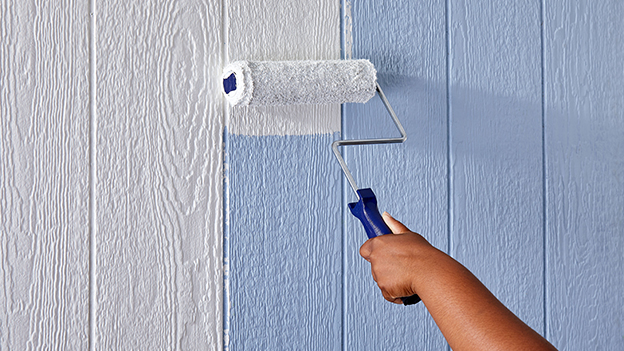Yes, painting over wood paneling is perfectly possible, with the right equipment. You'll need to prepare the paneling first with some cleaning and sanding, then apply primer before painting it.
Painting over wood paneling is one of the best ways to cover it or bring it up-to-date, helping it match your home’s style and theme. This guide will show you exactly how to paint over paneling, step by step, and answer some common questions on the subject.
THE DECISION TO PAINT YOUR PANELING
Wood paneling has its advantages, but it's not to everyone's taste. It can feel and look a little outdated or out-of-place, depending on the theme and style of your home. And, if you’re not happy with your home’s wood paneling, you’ve got a choice to make about how you’re going to deal with it.
You could remove the paneling, but that’s usually quite an expensive and time-consuming job. A second option is to stain it. Or you can paint it. Painting over wood paneling is often the best choice of all, as it’s highly affordable, very effective, quick, and perfect for making outdated and tired walls look much more modern, fresh, and aligned with your tastes.
The only real downside to painting is that, once you’ve started, it’s difficult to undo the process. If ever you change your mind about the color or style, you’ll need to restart the painting procedure again. That’s why it’s best to make this decision with care and choose the perfect paints and colors you like the most.
WHAT YOU'LL NEED
Can you paint paneling? Absolutely, but you'll need to gather all the necessary tools and supplies before you begin. Here's everything you'll need:
- Valspar® Stainblocking Bonding Primer/Sealer
- Valspar Reserve® Interior Paint + Primer
- Paint brushes
- Rollers
- Rags
- Caulking Gun
- Sandpaper
- Caulk
- All-purpose cleaner
- Putty knife
Naturally, the size of your project will impact the amount of supplies you require. Bigger rooms and sections of paneling will need more primer and paint. Make use of our handy paint calculator to get an accurate estimate of how much paint you’ll need.
HOW TO PREPARE YOUR PANELING FOR PAINTING
When it comes to how to paint over paneling, it's important to not simply rush ahead and start painting right away. You may end up with messy and uneven surfaces, if you fail to prepare your paneling properly. Here are the key steps to follow before you start painting over wood paneling.
STEP 1: CLEAN THE SURFACE
First, the paneling will need to be clean. This helps to prevent the paint clumping around bits of dirt and dust. It also helps the paint adhere to the surface properly. To start, wipe the paneling down with a damp rag. That should get rid of surface-level dust and dirt.
You can then use an all-purpose cleaner to remove deep-seated grime. Remember to let the paneling dry before moving on.
STEP 2: PATCH HOLES AND CRACKS
If your paneling is old and worn down, it's possible that it will have a few cracks or holes that need filling in. You can use putty and a putty knife to fill the gaps.
STEP 3: SAND THE WOOD
Finally, you'll need to sand down the wood with the help of sandpaper. This will create a grittier surface that the paint will stick to more effectively, while also getting rid of any little bumps or rough spots where the paint might clump.
HOW TO PAINT THE PANELING AND TRIM
Once you've done the prep, it's time to start painting. But how to paint over wood paneling? Here’s a quick breakdown of the process, in just three simple steps:
STEP 1: PRIME THE WOOD
Priming is recommended when painting over wood paneling. Without priming, the knots in the wood can bleed through and will be seen over time, ruining the intended effect of the paint.
Make sure to apply a good quality primer to start the process, using a brush to cover up grooves and knots. You can then move on to using a roller for bigger coverage, as needed. When painting over certain types of wood, such as cedar, redwood, and mahogany, you may need to use a stain-blocking primer to prevent tannin bleed.
STEP 2: PAINT THE PANELING
Next, you can start applying the paint to the paneling. Again, it's best to start off using a brush and focusing on the trickier areas, like big knots and grooves. You can then switch to a roller to cover up the rest of the paneling. Begin with an initial coat, let it dry, and then add a second coat, as needed.
STEP 3: PAINT THE TRIM
Finally, you can paint the trim of the paneling. Some people prefer to use a different color for the trim to make it stand out, or you might like to use a matte paint on the walls and a glossy one for the trim. This helps to distinguish between the two sections and may help to make the trim easier to clean, too.
Painting Paneling FAQs
Yes, it is possible. In certain cases, there may not be any reason to sand the paneling down. However, it can be helpful on older paneling to prepare it for the paint.
Interior acrylic paint can work very well on wood paneling. It tends to have better long-term durability and adherence to wood compared to oil-based paint.
Cleaning the paneling is a good first step. You may then wish to sand it down to help the paint stick better later, and always make sure to use a primer.


